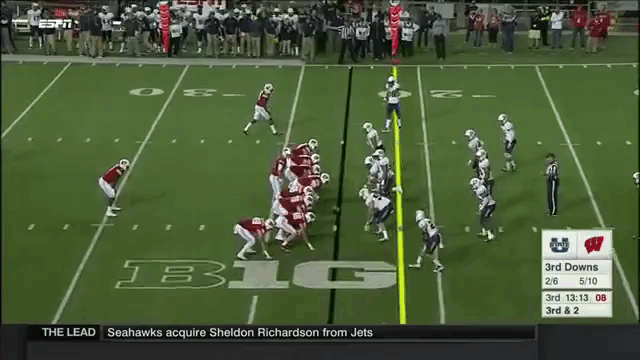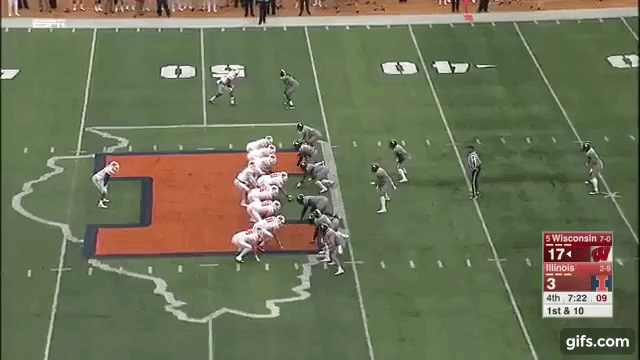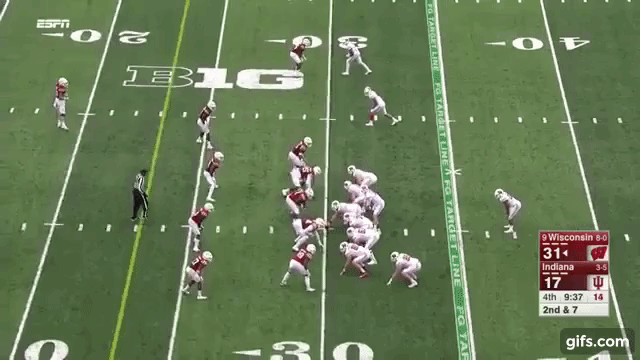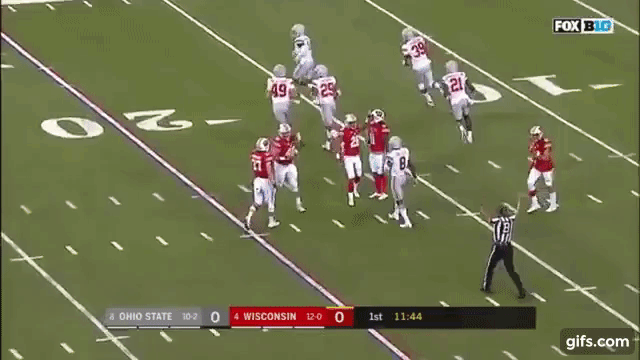Inside the Playbook: Wisconsin Swap Boot Part II
Previously, we touched on Wisconsin’s use of the Swap Boot in their 2-TE personnel package. In this post, we are going to look at the same concept, but instead of utilizing a TE in the flat, the RB is going to be incorporated into the pass concept. What we’ll see is a way of utilizing receiver’s in different spots on the field while keeping the reads and timing consistent for the QB.
Route and Reads
As noted, this is the same concept that was previously talked about. It takes a stretch play fake and then utilizes two separate pass concepts to form a triangle read: Yogi and Sail.
The read for the QB is also going to be the same with the “swap” route now being the RB rather than a backside TE:
Examples
Let’s first look at it utilized with jet motion. Here, the jet motion takes the place of the “stretch” play fake, and the RB is simply the same as a backside TE.
The Z-WR runs the jet motion and the OL stretches with the motion. Meanwhile, the RB works the arrow route immediately into the flat. The TE aligned toward the concept initially blocks down and runs a delayed release back toward the sideline.
The TE-Wing combo on the backside sees the inside TE run a crossing route and the outside TE run a delayed Pole route or deep angle, first mimicking the stretch blocking on the playside, and then holding the coverage from being able to fully rotate to the pass concept.
In this case, the safety responsible for coverage on the inside TE is also trying to work his run fit against the fly sweep; by doing so, he over commits down and loses his coverage, and the cross is wide open.
Same play, same story. Safety jumps outside to defend the run, and trails the crosser.
But the play can also be used without the jet fake. Here, Wisconsin will block the stretch fake away from the pass concept but he RB is going to take a weak fake in the direction of the concept so that he can quickly get to the flat. It’s a weak fake – one intended to freeze the defense more than move the defense – but enough to often allow the pass concept to gain leverage on the coverage (the blocking alone combined with the fake does the trick).
This design has a nice wrinkle to it. Wisconsin has two WRs lined up to the field and motions a wing back to the field to create a trips set, then runs the fake back into the boundary. Now, the slot WR can act as the “crosser” by running a deep out. The wing still down blocks before releasing back to the sideline, and the far TE runs his pole/cross to hold the backside of the coverage. Again, it is the crosser that is open.
On this play, we again see the “crosser” substituted for a playside receiver, now the outside Wing running the corner/deep out. The inside wing blocks down to mimic the stretch and then releases. The defense is going to do a good job in coverage on the RB and the QB works back inside to this delayed route for a decent gain.
Wisconsin came back with a twist on this same play from the same unique formation and was able to get outside the defense and dump it to the RB for a nice gain. This time, they used the inside wing to wall off the coverage and prevent the defense from fully rotating.
Route and Reads
As noted, this is the same concept that was previously talked about. It takes a stretch play fake and then utilizes two separate pass concepts to form a triangle read: Yogi and Sail.
The read for the QB is also going to be the same with the “swap” route now being the RB rather than a backside TE:
This “swap” route will be the QB’s hot read. If he gets pressure, he will immediate throw that route, which will often open up in the void vacated by the blitzing defender on the backside.
If he isn’t pressured, he’s generally going to work hi-lo on the sail concept, but he wants to get through the coverage quickly because this is a YAC concepts (pull the defense opposite, open up space on the other side to allow for catch and run). The crosser will be his first part of the progression in general. After his play fake, he will immediately peek to the defender lined up in initially in the flat to ensure he drops (he doesn’t want to throw into a squatting defender), and if he’s gaining depth or running with the post, then the coverage for this route needs to come from the inside. His first receiver in the progression being the crosser, he will quickly look to see if there is a defender sitting in the hook/curl zone. If that defender has worked forward, driving on the swap route, there should be an immediate void behind it for a big play to the crosser. If he hasn’t driven down, but has dropped or even just maintained his depth, then the QB will quickly move on and want to start working the in/out of the yogi concept by reading the flat/curl defender. Again, if there is any threat there with a defender underneath the crosser, the QB is to move on quickly, he may be coming back this way eventually, but he wants to get the ball out and into the hands of his playmakers in this scheme.
If he's moved off the crosser, his next read the curl/flat defender. If this defender has lost relation in his coverage, the arrow will be thrown (ball must get out, otherwise he will start moving into the sideline). If he maintains appropriate coverage on the arrow, the QB will work back inside to the curl/hook defender and read his depth. If he has gained depth or width, still maintaining him underneath the crosser, he will work to the stick. If he drives on the stick, he will move to back the cross.
Examples
Let’s first look at it utilized with jet motion. Here, the jet motion takes the place of the “stretch” play fake, and the RB is simply the same as a backside TE.
The Z-WR runs the jet motion and the OL stretches with the motion. Meanwhile, the RB works the arrow route immediately into the flat. The TE aligned toward the concept initially blocks down and runs a delayed release back toward the sideline.
The TE-Wing combo on the backside sees the inside TE run a crossing route and the outside TE run a delayed Pole route or deep angle, first mimicking the stretch blocking on the playside, and then holding the coverage from being able to fully rotate to the pass concept.
In this case, the safety responsible for coverage on the inside TE is also trying to work his run fit against the fly sweep; by doing so, he over commits down and loses his coverage, and the cross is wide open.
Same play, same story. Safety jumps outside to defend the run, and trails the crosser.
But the play can also be used without the jet fake. Here, Wisconsin will block the stretch fake away from the pass concept but he RB is going to take a weak fake in the direction of the concept so that he can quickly get to the flat. It’s a weak fake – one intended to freeze the defense more than move the defense – but enough to often allow the pass concept to gain leverage on the coverage (the blocking alone combined with the fake does the trick).
This design has a nice wrinkle to it. Wisconsin has two WRs lined up to the field and motions a wing back to the field to create a trips set, then runs the fake back into the boundary. Now, the slot WR can act as the “crosser” by running a deep out. The wing still down blocks before releasing back to the sideline, and the far TE runs his pole/cross to hold the backside of the coverage. Again, it is the crosser that is open.
Wisconsin came back with a twist on this same play from the same unique formation and was able to get outside the defense and dump it to the RB for a nice gain. This time, they used the inside wing to wall off the coverage and prevent the defense from fully rotating.
Conclusion
This is a great example of a team using the same concept with a different look. It keeps things simple and well rehearsed for the QB while giving the defense more to think about. But there's still more, we will look at one more Wisconsin rollout example in a future article.
This is a great example of a team using the same concept with a different look. It keeps things simple and well rehearsed for the QB while giving the defense more to think about. But there's still more, we will look at one more Wisconsin rollout example in a future article.














Comments
Post a Comment